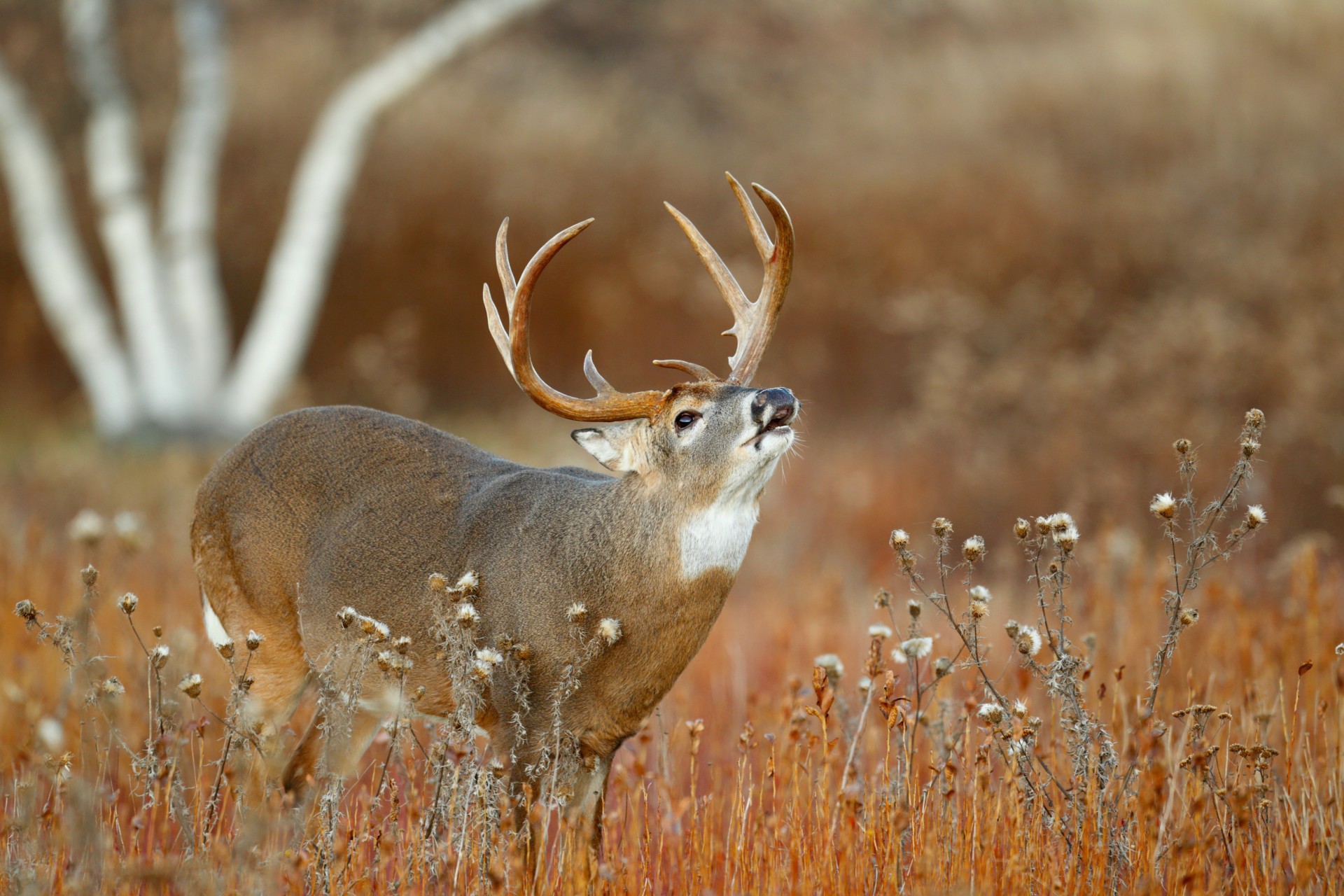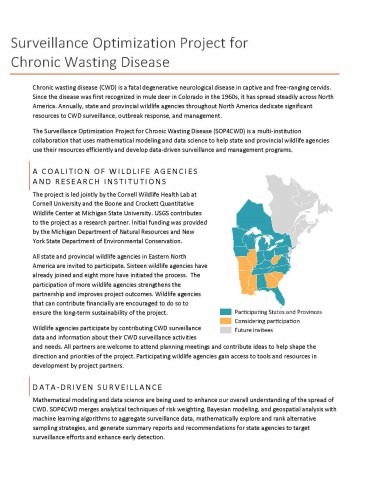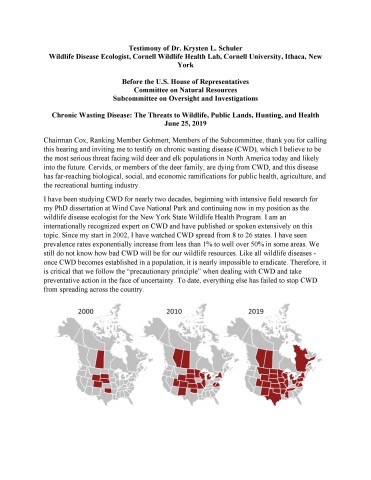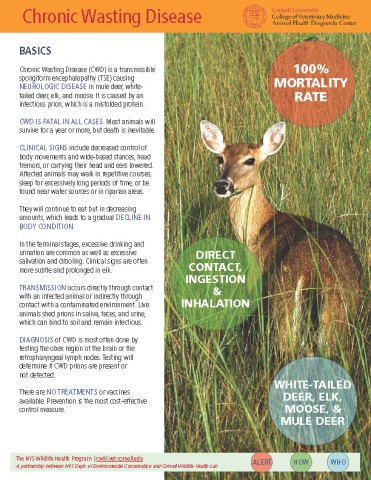Chronic wasting disease (CWD) is a fatal disease of white-tailed deer and other cervid species. Since 1967, when the disease was first discovered in captive mule deer in Colorado, CWD has spread across North America. To protect our native North American cervid populations, wildlife agencies are trying to slow the spread of the disease and prevent introduction to new areas. However, these goals have proven extremely difficult.
Disease surveillance, including efforts to detect new introductions quickly and measure changes in disease prevalence in areas where it exists, is an essential component of the disease response plans enacted by wildlife agencies across North America. But where should wildlife agencies focus their efforts? How much sampling is enough to determine if an area is ‘free of disease’ or to determine if the prevalence is increasing or decreasing? What does an efficient and effective disease surveillance plan look like?
We started the Surveillance Optimization Project for Chronic Wasting Disease (SOP4CWD) to address these types of questions and provide wildlife agencies with quantitative tools. SOP4CWD collaborators are applying methods from mathematical modeling and data science to address the challenges of disease surveillance by merging analytical techniques, including risk weighting, Bayesian modeling, and geospatial analysis, with machine learning algorithms.
A new toolbox for wildlife agencies
A product of the SOP4CWD collaboration is the CWD Data Warehouse, an online platform for CWD surveillance planning and data management available at no cost to state (US and Mexico), tribal, and provincial wildlife agencies in North America. The CWD Data Warehouse project was developed in partnership with DJ Case & Associates.
A suite of integrated CWD surveillance, modeling, and management applications within the Warehouse provides wildlife agencies access to the mathematical modeling and data science tools they need to efficiently plan surveillance efforts and make data-driven decisions. The CWD Data Warehouse facilitates interagency data-sharing, increasing situational awareness, and informing wildlife health decision-making.
The CWD Data Warehouse is designed around a conceptual model with three components: data, models, and visualizations. The Data component comprises the datasets, including CWD sampling and test data; cervid population demographics; CWD introduction risks; and current surveillance program activities. The datasets are stored in the Warehouse and serve as inputs for the Model component, a collection of mathematical models and analyses that can be set-up and run by the users. The Visualization component uses the Data and Model results as inputs and presents them as visual elements, such as interactive maps, graphs, and tabular summaries.
The CWD Data Warehouse supports the development of efficient and effective surveillance plans based on the best available science and mathematical methods. The Warehouse can also serve as the foundation of a data management system for agencies that need a reliable and efficient solution for their surveillance data management and processing. Although the Warehouse is not open to the public, wildlife agencies can use the products to inform and educate people about CWD.
Although this system is designed for CWD surveillance in cervids in North America, the framework serves as a template for other regional disease surveillance and management situations.
Participating States and Provinces
Data and input from participating wildlife agencies play a key role in SOP4CWD and the CWD Data Warehouse. More than 20 wildlife agencies participated in SOP4CWD and contributed to the development of the CWD Data Warehouse.
Wildlife agencies also share important information about their CWD surveillance programs. By engaging and contributing to the CWD Data Warehouse, wildlife agencies ensure that the analyses and products are relevant and can be integrated into existing surveillance programs. Additional tools and visualizations can be added to the Warehouse to meet the evolving needs of wildlife agencies.
Interagency data sharing is a principle aim of the Warehouse design. Sharing data and information across jurisdictional boundaries is critical for situational awareness and developing a deeper understanding of CWD to support better data-driven decisions.
Become a CWD Data Warehouse Partner
All North American state (US and Mexico), tribal, and provincial wildlife agencies are welcome to join the CWD Data Warehouse. The more partners we have, the stronger and better the outcomes of this effort will be.
In general, partner wildlife agencies joining the project are expected to be active and engaged partners by maintaining their CWD surveillance and ancillary data in the Warehouse. This includes best available population demographics; historic population management activities and hunting data; CWD sampling and test data; specific CWD introduction risks; and current surveillance program activities.
All participating agencies will approve the CWD Data Warehouse Data Use Agreement (DUA) prior to accessing and using the Warehouse. The DUA establishes the data sharing relationship and defines how agency data in the Warehouse can and cannot be used.
If you represent a wildlife agency that is not currently participating, please contact admin@cwd-data.org for detailed information on how to join.
SOP4CWD and the CWD Data Warehouse have been funded in part by the Michigan Department of Natural Resources through the Michigan Disease Initiative, the New York State Department of Environmental Conservation, the Association of Fish and Wildlife Agencies Multistate Conservation Grant Program, and through contributions from individual state wildlife agencies. SOP4CWD is jointly led by the Cornell Wildlife Health Lab and the Boone and Crockett Quantitative Wildlife Center at Michigan State University. USGS contributes to the project as a research partner.
Watch the latest presentation of the SOP4CWD Workshop and the CWD Data Warehouse
The following presentation was given on May 30, 2023, at the 4th International Chronic Wasting Disease Symposium in Denver, CO.








